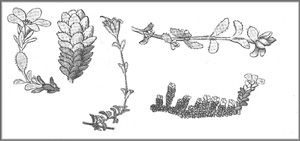Purple Saxifrage, Saxifraga oppositifolia
Amazing Story!

Purple saxifrage, Saxifraga oppositifolia |
Winters are long and cold throughout most of Canada, and the first flower of spring is always a welcome sight. In the Arctic, where winters are longest and coldest, Saxifraga oppositifolia is almost always the first plant to flower. And what flowers! Former Canadian Museum of Nature botanist Nicholas Polunin wrote in 1940 that this plant "must be reckoned among the world's greatest beauties, especially as it stands out in its unusually bleak and desolate surroundings." Bleak and desolate indeed -- it grows in areas so dry, rocky and inhospitable that it is often the only plant around.
Saxifraga oppositifolia is special from a scientific point of view, too. Early botanists thought that this plant was actually a number of species, because one plant can look quite different from another. Sometimes the leaves are tightly crowded on erect stems that grow so close together that the plant looks like a cushion sitting on the tundra. Other times the leaves are spread out on stems that sprawl flat across the ground. More recently, because genetically there's little evidence to suggest otherwise, researchers in Canada and Norway have concluded that there is only one species. The plants just look different according to the micro-climates in which they are growing. This attribute could be very useful for indicating changes that are occurring in microhabitats because of global warming.

Purple saxifrage can take many forms. Illustration: E. Warming. |
Scientists are still trying to understand an unusual feature of this polar desert-dwelling plant: it sometimes deposits crystals on the tips of its leaves. Researchers don't know why this happens, and they're particularly curious because other plants that do this live in warm deserts!
|

